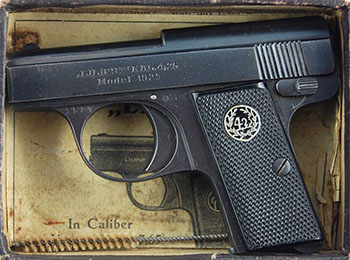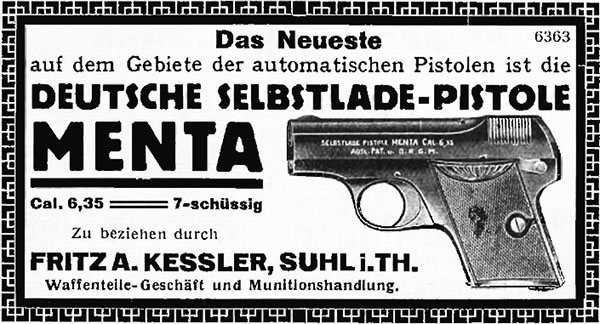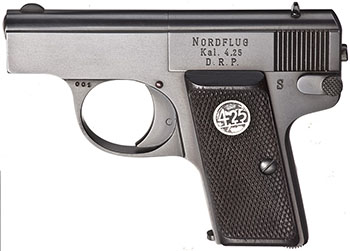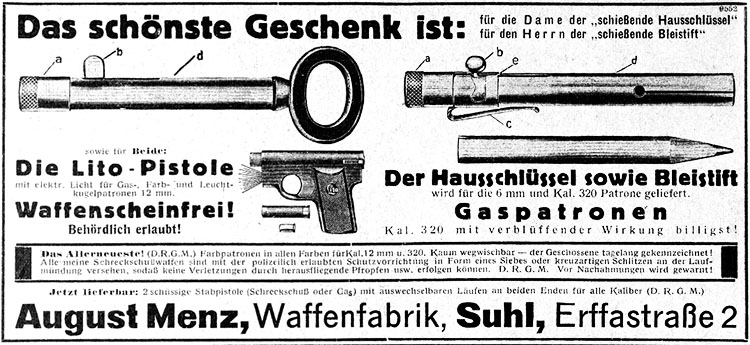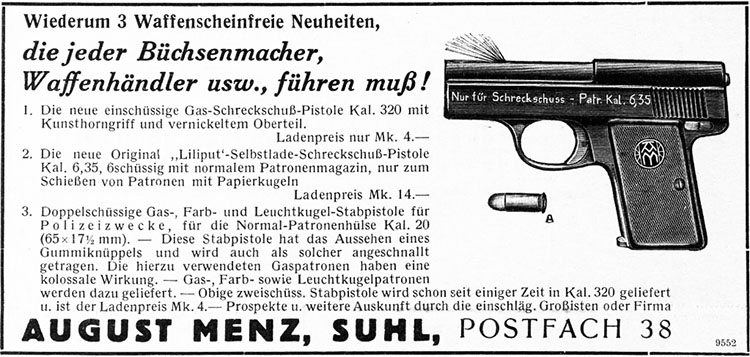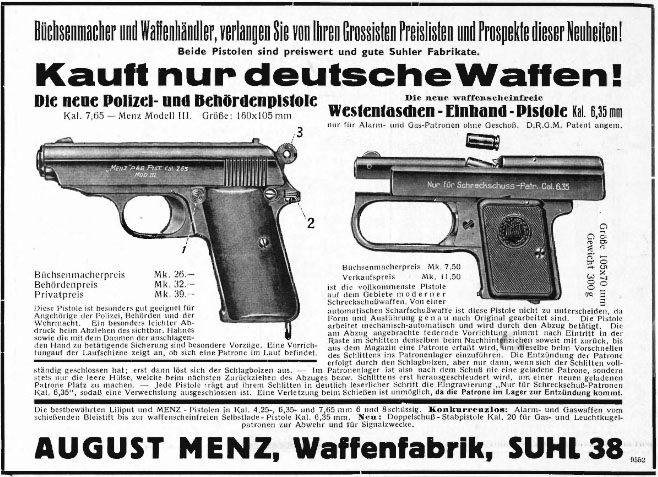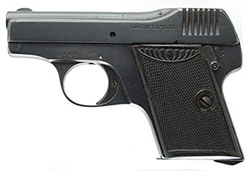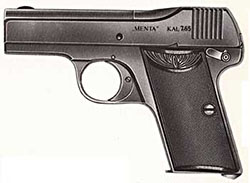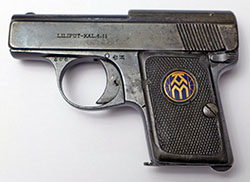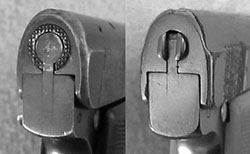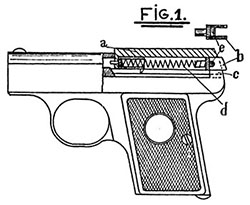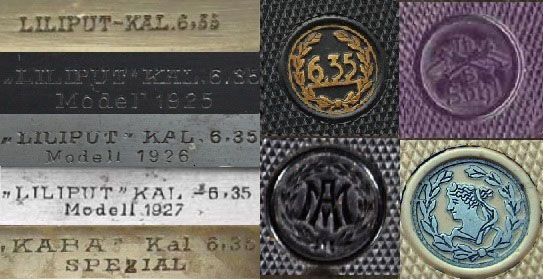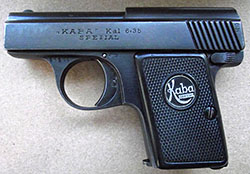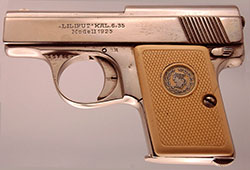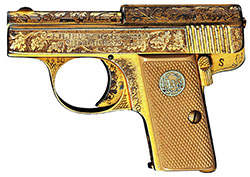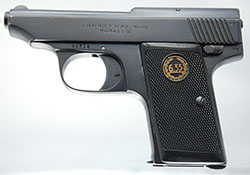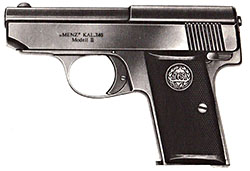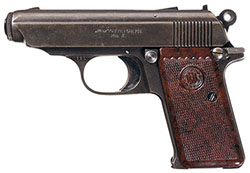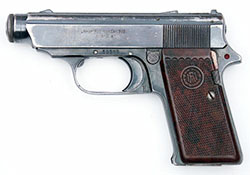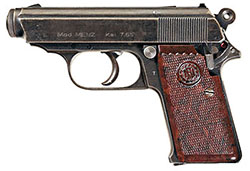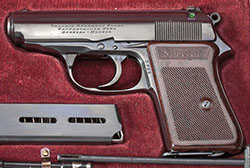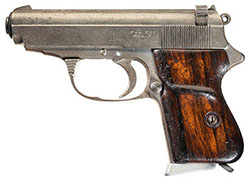 |
||||||||||||||||||||||||||||||||||||||||||||||||||||||||||||||||||||||||||||||||||||||||||||||||||||||||||||||||||||||||||||||||||||||||||||||||||||||||||||||||||||||||||||||||||||||||||||||||||||||||||||||||||||||||||||||||||||||||||||||||||||||||||||||||||||||||||||||||||||||||||||||||||||||||||||||||||||||||||||||||||||||||||||||||||||||||||||||||||||||||||||||||||||||||||||||||||||||||||||||||||||||||||||||||||||||||||||||||||||||||||||
|
The History of the by Dr. Stefan Klein
The primary source for information in this article is the magazine Waffenschmied (gunsmith), issues from 1900 to 1945. The Waffenschmied was a bi-weekly newspaper for gunsmiths and weapon and ammunition sellers. During our research we also found a very comprehensive article, “Ein Blick zurück – Die Pistolen der Waffenfabrik August Menz, Suhl” by R.A. Dvorsky and H.J. Tillig which was published in the Waffen Digest 1988 (Motorbuch Verlag, Stuttgart). Additionally we found an article by James P. Stewart, “The handguns of August Menz,” which was published in the Gun Collectors Digest for 1974. Most later articles in the German language appear to be based on Dvorsky and Tillig, however Dvorsky and Tillig may have been unaware of Stewart’s article. Finally, in regard to the Menz P.B. Spezial, we have a superb article by Joe Wotka and Martin Krause, entitled ‘Revisiting the History of the Menz/Bergmann PB “Spezial” Pistol,’ which is a revision of an earlier article published in AutoMag, the journal of the National Automatic Pistol Collectors Association, provided to us in pre-publication form by Joe Wotka. Each source contains useful information, but may include some incorrect data. The article below is an aggregation of information from the above sources, along with our own observations from examining various Menz pistols. Reportage and articles in the Waffenschmied enabled us to uncover and correct certain inaccuracies found in our other source materials. Any errors remaining are of course our own.
August Menz was born in 1861 and worked as a mechanic and gunsmith. In 1905 he founded his own company which produced parts for other gun manufacturers. In 1908 he made his first essay into the handgun field with a repeater known as the Regnum. It consists of four superposed barrels chambered for the 6.35mm Browning cartridge. Stewart notes that: “Sequential fire is accomplished by a rotating hammer shaped somewhat like an automotive engine crankshaft. The hammer is indexed by a pawl in the double-action lockwork so that successive pulls on the trigger result in the discharge of the barrels in sequence.” Due to the fact that there were already a number of modern self-loading pistols on the market, the Regnum was not very successful. In 1911 Menz produced a gas-pistol with three superposed 12mm caliber barrels, known as the Scheintod, for which he obtained a utility model (Deutsches Reich Gebrauchsmuster, DRGM), No. 478715. In 1913 Menz presented his first self-loading pistol, the Menta (Menz Taschenpistole) in 6.35mm Browning. We found no patent for the Menta, so we must assume it was covered by one or another of the utility models listed below, for which we have no information other than the bare description. It has been suggested that the method of barrel attachment, via a dovetail fitting from the rear, is based on a design by Alois Tomiska (or Tomischka): British patent 23927 of 1910. However, Tomiska’s patent did not include the transverse pin seen in the Menta and indeed claimed that “no additional connecting means [between barrel and frame] are ... required for holding the barrel in position.” A 7.65mm Browning version of the Menta, which was slightly larger, followed just prior to WWI.
With the beginning of WWI the German firearms industry focused on military production. Demand for the 08-Pistol (the Parabellum Luger) could not be fulfilled, so other guns were also called into use as service guns. Menz manufactured the Menta 7.65mm pistol for the war effort, but due to high demand other manufacturers such as the Westdeutsches Walz- und Presswerk Becker & Holländer were ordered to produce the pistol. The Becker & Holländer pistol is known as the Beholla. August Menz died on 6 September 1918. The Waffenschmied article from 25 September 1918 reports that Menz had turned a small business into a remarkably successful company. His son Alfred, born in 1886, took over the business after his death. After the war firearms production was a difficult business due to treaty restrictions and low demand for handguns. But Alfred Menz continued production of the Menta pistol, which was equipped with a new barrel release. The 6.35mm version was eventually renamed and offered as the „Menz 6,35“. Becker & Holländer was sold to Stenda-Werke GmbH which produced the pistol with an improved barrel fixation method until 1926. Stenda was granted a new patent in 1920 (Deutsches Reich Patent, DRP 334449). The Metallwarenfabrik Hugo M. Gehring in Arnstadt also produced the pistol as the Leonhardt until 1925. The Leonhardt was identical to the WWI Menta.
According to Dvorsky and Tillig, in 1922 or 1923 Menz built a new 4.25mm pistol, the „Liliput“, and some time later a version in 6.35mm Browning followed. On the other hand Stewart gives late 1923 as the production date for the Liliput. In 1925 Menz was granted a French patent (No. 603742) which in turn mentions a German patent filed on 2 October 1924, which we have been unable to locate after considerable searching. Possibly the filing date for the German patent is incorrect, or perhaps the patent was never granted in Germany. Quite interesting is the question why – according to Dvorsky and Tillig – Menz was selling his pistol a year or two before a patent was granted. The first advertisement we have located for the Liliput (6.35mm) appears in the Waffenschmied for March of 1924, and Gerhard Bock’s book Moderne Faustfeuerwaffen und ihr Gebrauch, published in 1923, mentions the Menta but not the Liliput. We conclude that a manufacture date in late 1923 or early 1924 is likely. Virtually all sources state that the 4.25mm Liliput was manufactured before the 6.35mm version. However, the earliest 4.25mm Liliput pistols are very clearly marked “Modell 1925,” which means the 4.25mm Liliput could not have preceded the 6.35mm Liliput. The first advertisement we have located for the Liliput is dated 25 March 1924 and is for a 6.35mm, and we have also located a box for a 6.35mm Liliput which has the date of purchase written on it: 5 September 1924. Perhaps the Liliput’s similarity to the Nordflug has caused people to believe the 4.25mm appeared before the 6.35mm, but the evidence seems to prove otherwise. On 01 January 1928 Menz took over the Gewehrlauffabrik (rifle barrel factory) Schlegelmilch which had existed since 1818. He equipped it with new machinery and began production of rifle barrels in the same year.
Also in 1928 Menz presented a slightly larger Liliput pistol in 6.35mm, which held 8 rounds in the magazine, and which was designated the Modell II. At the same time the 7.65mm Liliput was slightly reconfigured and renamed the Modell II. On 12 April 1928 Germany passed a new gun law requiring that most guns be registered. This had a significant, negative impact on gun sales in Germany. The Waffenschmied reported on the 25th jubilee of the Menz company in November 1930 that Menz had announced the company was forced to focus on gas pistols due to restrictions in the new law. Nevertheless, production of the Liliput Model I in 4.25mm and 6.35mm caliber and the Model II in 6.35mm and 7.65mm caliber was continued. Despite these difficulties Menz was very creative and provided several new products for the fast growing market of blank and gas pistols: Gas pistols with integrated flash light, pistol frames made out of horn, shooting keys and pencils, double shot sticks with different replacement barrels up to .20 caliber, and many others. The list of utility models and patents in this article provide an overview of his creativity in this regard. Menz seems to have had some legal issues; the Waffenschmied reports on a certification which was issued to prove his blank pistols were not covered by the new gun laws. The Menz blank pistol had a special barrel design which allowed it to shoot gas and paint bullets but prevented the shooting of ball and shootshell ammo (DRGM 1189529)
In 1932 Menz presented three novelties. A quite interesting one was a six-shot selfloading blank pistol, the design of which was identical to the Liliput pistol. It fired paper bullet cartridges which were pulverized before they passed the muzzle. The tiny paper pieces were directed upwards to the front. Even at a distance of 20cm the remains of the paper bullet did no damage to a sheet of newspaper.
In 1933 Menz created a series of new, larger pistols in 7.65mm, the Models III, IIIA, IV and IVA, which he collectively referred to as the Polizei- und Behördenpistole (P&B). These pistols differed little from each other, using essentially the same slide and frame with only minor modifications.
In October 1935 the August Menz Company was renamed Menz & Co Kommanditgesellschaft (Waffenschmied, 14. October 1935). The footnote of the following ad from 1935 announces a new product – the „P.B.-Hahn-Pistole mit Revolverabzug und auswechselbaren Läufen“ (double action pistol with external hammer and interchangeable barrels), later known as the “P.B. Spezial.” Menz had bought the patent from Adalbert Kàdits. According to Dvorsky and Tillig the gun was sold as the “P.P.” (Polizeipistole), but all the evidence we have indicates the gun was advertised and sold as the “P.B.” (Polizei und Behörden). Whichever is correct, Walther filed suit against Menz over the name, which they regarded as too similar to their own product. Walther eventually won this suit.
According to Dvorsky and Tillig, Alfred Menz sold his company to the merchant Theodor Emil Bergman from Berlin in 1938. The sale was likely a result of the legal costs of the aforementioned lawsuit. Theodor Emil belonged to the Theodor Bergmann family from Gaggenau, which had sold its business to Lignose AG in 1922. A number of English-language sources report that the Menz company was sold to Lignose, but we do not believe this to be the case, as Lignose had announced they were leaving the firearms business in 1928 (the Waffenschmied, 28 September 1928). Unfortunately the Waffenschmied does not mention a single word about the transfer of the Menz company to a member of the Bergmann family, which would in our opinion have been important news at the time. Bergmann produced the Menz pistols with the inscription “Theodor Bergmann Erben, Waffenfabrik Suhl,” and continued to refer to the larger gun as the “Spezial” but omitted the “P.B.”. The Waffenschmied for 14 May 1940 reports that Theodor Bergmann Erben received two Gebrauchsmusters (utility models), but it must have been right around this time that Bergmann Erben went out of business for reasons as yet undetermined.
August and Alfred Menz secured all their products with patents and utility models. (The German utility model is similar to a patent but has a shorter term and less stringent requirements.) Up until 1927 the utility models were applied for under the name of August Menz. Patents:
Utility models (DRGM):
The following chapter will present the Menz selfloading pistols. It will focus on the inscription variants and differences. Vestpocket pistols of the era were based on very similar technical principles so we will not describe each gun’s mechanism in detail. Due to the large variety of models and variants we cannot guarantee completeness.
The Menta is an unlocked breech striker fired pistol that features an open top slide. The barrel is fixed to the frame with a dovetail guide held in position by a transverse pin. For disassembly the pin must be pushed out through a hole in the slide, then with the slide locked to the rear the barrel may be pushed backwards and lifted out of the frame, after which the slide can be removed. The later (post war) version employed a rotating lever on the left side above the trigger to release the barrel. The early grips are made of checkered horn with an abstract design
Export versions are sometimes found stamped “GERMANY.” The 6.35mm pistol is smaller than the 7.65mm pistol and can be found with the early inscription: DEUTSCHE SELBSTLADE-PISTOLE “MENTA” CAL.6.35 Later inscriptions are much simplified: „MENTA” 6,35 and the late (post WWI variant) inscription: „MENZ” 6,35 Early 6.35mm pistols had 9 flat-bottomed vertical slide serrations. These were later reduced to 7 and later still to 6. The 7.65mm Menta had the ejector on top of the slide, like the 6.35mm version, but very early in production (at least by serial number 1365) it was moved to the right side. The 7.65mm model has two inscription variants which differ only in character height and spacing: „MENTA” KAL 7,65 and „MENTA” KAL. 7,65
One can hardly fail to note the similarities between the Walther Model 9 and the Menz Liliput. From a distance they could almost appear to be the same gun, the frames being nearly identical, with fixed barrel, open-top slide, top-mounted internal extractor, and a disassembly mechanism at the rear. But there are significant differences in the sear mechanism, the
The early Liliput disassembly mechanism involves a rotating collar held in place in the slide by a transverse pin. The safety lever is used to lock the slide back a mere 5 or 6 millimeters; then the collar can be rotated clockwise, after which the slide can be lifted upward (the striker spring must prevented from flying off) and removed. When the gun is assembled the rear portion of the collar fits around the backstop for the striker spring, sometimes referred to in English as the “doll’s head.”
Somewhere in the 1925 series the spring guide rod is replaced by a short bolt. The early spring guide rod protrudes through the front of the slide. The short bolt of the later version is held in place by a notch inside the front of the slide and does not protrude. With the introduction of the larger Model II in 1928 the name changes from Liliput to “Modell I”. Export versions of the Liliput are found stamped “GERMANY.” Liliput pistols in 6.35mm are known with the following inscriptions on the left side of the slide (from early to late): LILIPUT-KAL. 6,35 LILIPUT KAL. 6,35 „LILIPUT“ KAL. 6,35 „LILIPUT“ KAL. 6,35 „LILIPUT“ KAL. 6,35 „LILIPUT“ KAL. 6,35 The pistols were also sold under the name BIJOU in Belgium and as ORZEL in eastern countries. We find pistols with the inscriptions: „ORZEL“ Kal. 6,35 BIJOU BI No 325664
The company Karl Bauer from Berlin sold the pistol with the inscription „KABA“ Kal 6,35
The Liliput was offered in nickel, gold and engraved variants, all of which had white grips. A special variant of the Liliput was the 6.35mm blank pistol for cartridges with paper bullets. The left side is marked: “Nur für Schreckschuss-Patr. Cal. 6,35”. Externally nearly identical to the 6.35mm Liliput a close look shows it to not even be a real gun. Early versions have what appears to be a true barrel, but is only a fraction of an inch deep and does not reach the chamber. Later versions have three small holes drilled in the front. All have an angled hole drilled into the top of the barrel to meet the bore, and some have an additional vertical hole behind this. 4.25mm pistols can be found with the following inscriptions: „LILIPUT“ KAL. 4,25 „LILIPUT“ KAL. 4,25 „LILIPUT“ KAL. 4,25 „LILIPUT“ KAL. 4,25 The 4.25mm pistols were offered in nickel, gold plate, and engraved versions. These deluxe models had white grips with an emblem which reads 4,25 in a laurel wreath. The Liliput (Model I) in 7.65mm exists in two variants with differing slide serrations. We know the following inscription variants: „LILIPUT“ KAL. 7,65 „LILIPUT“ KAL. 7,65 „LILIPUT“ KAL. 7,65 „LILIPUT“ KAL. 7,65 „MENZ“ KAL. 7,65 „MENZ“ KAL. 7,65 7.56mm grips show the “AM” monogram or “7,65” with a laurel wreath. We have found red, green, and black boxes with a gold „Liliput 6,35“ inscription, and brown boxes with “AM” in a laurel wreath and “Liliput 6,35.” Boxes come with manual and cleaning rod.
We know two variations of the 6.35mm Model II, one labeled for Menz and the other labeled for Bergmann. We find the following slide inscription on the left side of the Menz: „Menz“ KAL. 6,35 The Bergmann pistol has a three-line inscription: THEODOR BERGMANN ERBEN and on the right side Modell II. Kaliber 6,35
The Model II was also offered in nickel. We do not know if gold and engraved variants exist. Pawlas shows three types of the 7.65mm version, with different slide and barrel contours. Grips show 7,65 or AM in a laurel wreath. The inscriptions are identical: „MENZ“ KAL. 7,65 Additionally we were able to find a Model II with a VENUS inscription. We do not know if Theodor Bergmann Erben continued production of the 7.65mm variant. PAWLAS does not show it.
In 1933 and the years following Menz offered a series of new selfloading pistols which were named “Polizei- und Behördenpistole” (PB, Police- and law agencies pistol). These Models are ultra rare and expensive. The Models III, IIIA, IV, and IVA use essentially the same frame with only minor modifications. The safety lever is at the rear and the magazine release is behind the trigger. Disassembly is via a lever on the right side of the gun, just above the bow of the trigger guard--when this lever is depressed the slide can be drawn back and lifted up off the frame.. There is a loaded chamber indicator on top of the slide in the form of a small blade that sticks up when there is a round in the chamber. We have been unable to examine these guns in person and so must rely on our sources for detailed information. These pistols all have brown grips with the “AM” monogram in a laurel wreath.
„MENZ“ P&B PIST CAL. 7,65 At the same time Menz offered the Model IIIA, which was a striker-fired version like the earlier Menz pistols, with no external hammer. The inscription reads: „MENZ“ P&B PIST CAL. 7,65
„MENZ“ P&B PIST CAL. 7,65 Some time ago a Model IV was sold in the US (serial number 7) with an inscription which reads simply “Mod MENZ Cal 7,65” The low serial number and simple slide inscription probably indicate that this is a prototype, and in fact this model may never have reached full production.
„MENZ“ P&B PIST CAL. 7,65 Stewart is doubtful that any of this series of pistol were produced in any great quantity, and states that only the Model III was ever shown in contemporary catalogues. Later Menz refined the P.B. idea, using a design from Adalbert Kàdits for a selfloading pistol with double action trigger and interchangeable barrels. (See German patent 734985, filed by Hermann Weihrauch Gewehr- und Fahrradteilefabrik--but Martin Krause has discovered that the true author of this design was Adalbert Kàdits.) This gun was known as the P.B. Spezial or P.B. Special. The outer form is quite similar to the Walther PPK, with disassembly accomplished by pulling down a lever at the front of the trigger guard. This design has some interesting features which made it unique when compared to competing products. The safety, which is on the slide, rotates the firing pin block out of alignment with the hammer. According to Stewart: “...it was, in fact, a two-stage double action.
We find the following inscriptions: WAFFENFABRIK AUG. MENZ SUHL AUGUST MENZ WAFFENFABRIK SUHL WAFFENFABRIK AUG. MENZ SUHL MENZ SPEZIAL MODELL T H E O D O R B E R G M A N N E R B E N The black or brown grips show the word “Special.” Wotka and Krause point out that the grips are made of Galalith, a plastic- like substance derived from casein which turned out to be not very good for the purpose as they are quite brittle and easily broken.
Conclusion Menz built a quite impressive number of fascinating, inventive and handsome pistols. We hope this research contributes to the history of the August Menz company. Perhaps the reader will now see Menz pistols in a different light. |
||||||||||||||||||||||||||||||||||||||||||||||||||||||||||||||||||||||||||||||||||||||||||||||||||||||||||||||||||||||||||||||||||||||||||||||||||||||||||||||||||||||||||||||||||||||||||||||||||||||||||||||||||||||||||||||||||||||||||||||||||||||||||||||||||||||||||||||||||||||||||||||||||||||||||||||||||||||||||||||||||||||||||||||||||||||||||||||||||||||||||||||||||||||||||||||||||||||||||||||||||||||||||||||||||||||||||||||||||||||||||||
|
Copyright 2015 by Stefan Klein and Ed Buffaloe. All rights reserved. |
||||||||||||||||||||||||||||||||||||||||||||||||||||||||||||||||||||||||||||||||||||||||||||||||||||||||||||||||||||||||||||||||||||||||||||||||||||||||||||||||||||||||||||||||||||||||||||||||||||||||||||||||||||||||||||||||||||||||||||||||||||||||||||||||||||||||||||||||||||||||||||||||||||||||||||||||||||||||||||||||||||||||||||||||||||||||||||||||||||||||||||||||||||||||||||||||||||||||||||||||||||||||||||||||||||||||||||||||||||||||||||
|
|
||||||||||||||||||||||||||||||||||||||||||||||||||||||||||||||||||||||||||||||||||||||||||||||||||||||||||||||||||||||||||||||||||||||||||||||||||||||||||||||||||||||||||||||||||||||||||||||||||||||||||||||||||||||||||||||||||||||||||||||||||||||||||||||||||||||||||||||||||||||||||||||||||||||||||||||||||||||||||||||||||||||||||||||||||||||||||||||||||||||||||||||||||||||||||||||||||||||||||||||||||||||||||||||||||||||||||||||||||||||||||||
